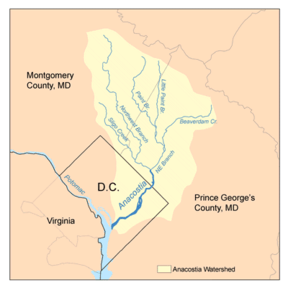Sligo Creek
| Sligo Creek | |
| River | |
 The creek running through Silver Spring, Maryland | |
| Country | United States |
|---|---|
| State | Maryland |
| Tributaries | |
| - left | Long Branch |
| - right | Wheaton Br, Comstock Br, Takoma Park Br |
| City | Silver Spring, Maryland |
| Source | |
| - location | Kemp Mill, Maryland |
| - elevation | 450 ft (137 m) |
| Mouth | Northwest Branch |
| - location | Hyattsville, Maryland |
| - elevation | 35 ft (11 m) |
| - coordinates | 38°57′32″N 76°58′26″W / 38.959°N 76.974°W |
| Length | 9.1 mi (15 km) |
| Basin | 11.6 sq mi (30 km2) |
| Discharge | for Takoma Park |
| - average | 26 cu ft/s (1 m3/s) |
| - max | 49 cu ft/s (1 m3/s) |
| - min | 3.3 cu ft/s (0 m3/s) |
 Map of the Anacostia River watershed showing Sligo Creek
| |
Sligo Creek is a free-flowing tributary of the Northwest Branch of the Anacostia River in Maryland. (The Anacostia, in turn, feeds into the Potomac River and eventually empties into the Atlantic Ocean via Chesapeake Bay.) The creek is approximately 9.1 miles (14.6 km) long,[1] with a drainage area of about 11.6 square miles (30 km2).
Geography
The creek rises in the Kemp Mill section of Silver Spring in Montgomery County and joins with Northwest Branch near the city of Hyattsville in Prince George's County. The lower portion of the creek has been channelized. Elevations in the subwatershed range from 450 feet (137 m) above sea level to 35 feet (11 m) at the confluence with Northwest Branch; the average gradient for the course of the creek is 0.72%.
Contributing streams that flow into the creek include Wheaton Branch, Comstock Branch, Takoma Park Branch, and Long Branch.
Sligo Creek is one of the most heavily urbanized subwatersheds in the Anacostia watershed, with a population density of 7,081 people per mi2. 75% of the watershed is in Montgomery County, 20% is in Prince George's County, and 5% is in the District of Columbia. Less than 15% of the subwatershed is undeveloped, and only 10% is forested. Less than 0.01% of the area is wetlands.[2]
From its source to the confluence with the Northwest Branch, the creek crosses through the communities of Silver Spring, Wheaton, Takoma Park, Carole Highlands, Chillum and Hyattsville. In these towns, the banks of the creek are in many stretches maintained as public parkland, with grassy lawns and playing fields.
The Sligo Creek Trail, a hiker-biker trail, runs along the creek from Wheaton to the confluence, where it connects with the Anacostia Tributary Trail System. An automobile parkway runs along many parts of the creek in Montgomery County.
History
Sligo Creek was named after the crossroads named "Sligo" founded in the mid 19th century by Irish immigrant workers on the C&O Canal. It may have been named after County Sligo in Ireland. The crossroads was located at Colesville Road and the 7th Street Pike, currently the corner of Colesville Road and Georgia Avenue in Silver Spring. At the time of the Civil War, Sligo had a toll gate on the 7th Street Pike, an inn and a post office. A half mile from the Sligo crossroads Colesville Road crosses Sligo Creek.
Over the years, Sligo Creek has served many purposes for area residents, including powering grist mills and as a drinking water source. In the Takoma Park section of the creek (near Washington Adventist University), the remains of a dam and associated building foundations for the Sligo Creek Waterworks can still be seen. From 1900 to 1930, the waterworks served the city of Takoma Park, as well as (after its sale in 1919 to the Washington Suburban Sanitary Commission) Silver Spring, Kensington, and Bethesda.
Another dam, located where Flower Avenue crosses Sligo Creek, served Sligo Mill which was located where the current New Hampshire Avenue crosses Sligo Creek. Sligo Mill was built in 1812 by investors that included several members of the prominent Maryland Carroll family. In addition to milling grain for local farmers, Sligo Mill distilled whiskey. The mill was demolished in the 1920s.
Overlooking the dam and millpond for Sligo Mill on the right bank of Sligo Creek, the Glen Sligo Hotel and Wildwood Amusement Park were built in 1900. The hotel and amusement park ceased operations in 1903.[3][4]
Sligo Creek served as the inspiration and title for "Sligo River Blues", a song by Takoma Park guitarist John Fahey, who popularized the area amongst folk artists.[5]
Another prominent folk guitarist, Al Petteway, composed "Sligo Creek" while living in the Takoma Park area. This Scots-influenced guitar tune was later featured as the theme song of The National Parks, a PBS miniseries directed by Ken Burns.
See also
- List of Maryland rivers
External links
| Wikimedia Commons has media related to Sligo Creek. |
- Sligo Creek - Watershed Assessment - Montgomery County Department of Environmental Protection
References
- ↑ U.S. Geological Survey (USGS). National Hydrography Dataset high-resolution flowline data. The National Map, accessed August 15, 2011
- ↑ Anacostia Watershed Restoration Partnership, Washington, DC. "Sligo Creek: Profile." Accessed 2009-08-31.
- ↑ Friends of Sligo Creek (FOSC), Takoma Park, MD. "Fabulous Glen Sligo Hotel Spices Early Takoma History." Originally published in The Takoma Journal, June 30, 1950.
- ↑ FOSC. "The Closing of the Wildwood Poolroom at the Glen Sligo Hotel." Articles originally published in The Washington Post, 1903-1904.
- ↑ FOSC. "John Fahey and the 'Sligo River Blues'." Accessed 2012-05-07.
- USGS. "Current Conditions for Sligo Creek near Takoma Park, MD." USGS Station ID 01650800. Accessed 2012-05-07.
| |||||||||||||||||